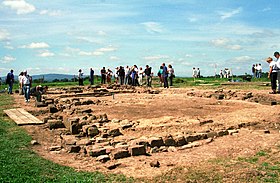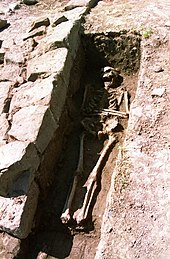66:
205:
24:
145:(1099–1153), Earl of Chester and Pincerna's overlord was a prisoner of King Stephen at the time and Pincerna wished prayers to be said for the Earl and his family. On his release the Earl confirmed the foundation and granted the monks a fishery in the River Dee and an exemption for them to grind their corn at his mill in Chester. Numerous other gifts were bestowed on the abbey.
364:(Recollection of ‘Old Richard Langford’ (c.1540), cited John Jones of Gellilyfdy, Cardiff, Central Library MS 2.634 (Hafod 24), p. 355–6. See also Daniel Huws, ‘Yr Hen Risiart Langfford,’ in Beirdd a Thywysogion: Barddoniaeth Llys yng Nghymru, Iwerddon a’r Alban, cyflwynedig i R.. Geraint Gruffydd, ed M. E. Owen and B. F. Roberts (Caerdydd, 1996), 302–23.
173:
The chapel was still extant in 1544 when it was granted to Sir George Cotton by the King, although the rest of the buildings had long since fallen into decay. "The king granted to Sir George Cotton...the...chapel of Pulton by Patent dated Dec. 20 1544... 'The remains of the monastery have been long
105:
The earliest ecclesiastical structure on the site is thought to have been a single-cell structure built in the Saxon period, as evidenced by some 170 pieces of Anglo Saxon pottery, specifically 10th century
Chester Ware, that have been found in conjunction with the earliest phase of construction.
195:
S. Harper cites the above and says: "The suggestion that all of this happened as the people celebrated a vigil, in the main place of worship within the township of
Poulton, is important; the setting is evidently not the formal liturgy, but it does taken place in a chapel, likely on the eve of a
260:
Furthermore, Iron Age occupation of the site has also been established, with a number of round house ditches having been excavated and a large number of others identified by geophysical survey. Dr Kevin Cootes, site director, believes that the assemblage of animal bone and
237:
proposed the theory that the chapel was a "Capella ad Portem", or chapel by the gate; a chapel that could be used by the local population who could not access the abbey chapel. Other such chapels exist, such as St. Stephens at
229:
programme called "The Abbey Habit". The weekend dig failed to find any evidence of the location of the abbey, but did establish that an abbey grange, known later as
Poulton Hall, was approximately 500 metres from the chapel.
252:
In addition to the chapel itself, archaeologists have uncovered Roman ditches which have surrendered a wide range of Roman artefacts, suggesting a high status Roman building on the site and linking the Roman presence to the
177:
The last recorded use of the chapel was during the
English Civil War (1642–1651), when it became a stables and lookout point for Parliamentarian troops. In 1672 it was reported as ruinous and by 1718 it had been demolished.
151:
After the abbey was moved to
Dieulacres by Randle Blundeville, the site remained a grange, or farm estate of the abbey. The chapel appears to have been maintained for the use of the lay brothers who farmed the estate.
121:
between 1199 and 1214. However, foundation must have occurred by 1153 at the latest as Ranulf de Gernon died in 1153. The exact location of the abbey has yet to be established as no above ground structure remains.
373:‘So that the people can sing together in church’: Aspects of the parish soundscape in Wales c. 1500 – c. 1630 Sally Harper - "The Welsh Mediaeval Church and its Contexts" November 2008 Conference Paper.
213:
192:(A long time ago when we kept vigil in the chapel of Mary of Poulton , the gwŷr wrth gerdd would sing cywyddau and awdlau and the women would sing carolau and dyrïau.)"
196:
liturgical feast (perhaps a day when it was customary for professional bards to be paid). The occasion may even have been a pilgrimage to a local shrine or well."
148:
The chapel building appears to have been contemporary with the foundation of the Abbey (c.1153) and comprised a single nave from the earliest phase of building.
45:
156:
220:, then later by the Poulton Research Project, who have been digging both the immediate chapel environs and a number of other features in the vicinity.
138:
189:"Ir ystalm pan oeddem i yn gwilio ynghapel Mair o Bylltyn, ir oedd gwyr wrth gerdd yn kanu kywydde ac odle, a merched yn kanu karole a dyrïe.
89:
437:
32:
249:
The mediaeval graveyard burials are still being uncovered and eight hundred plus burials have so far been excavated (as of 2015).
340:
141:. Abbot William of Combermere founded Poulton Abbey with an endowment of land from Robert Pincerna Le Botiller (1100–1158).
481:
217:
155:
In 1487 the abbey leased the estate of
Poulton Hall to the prominent Manley family and the chapel was expanded by
65:
85:
476:
265:
strongly suggests that the site was being used for meat production, preservation (by salting) and trade.
166:, thought to have been drawn before 1675. Subsequent estate maps also recorded the chapel and the first
382:
Poulton Hall, Pulford, Cheshire - Archaeological
Evaluation and Assessment. Wessex Archaeology, 2007.
317:
vol. 2, pg. 106 & 682, "The
History of the County Palatine and City of Chester" by George Ormerod
204:
254:
37:
392:
186:
The chapel was referred to in a sixteenth century document as the Chapel of Mary of
Poulton.
117:. According to Janauschek, the abbey itself was founded between 1153 and 1158, but moved to
8:
77:
336:
290:
Dr. K. Cootes, British
Archaeology Magazine November/December 2015. Exact Editions.
212:
The site has been under investigation since 1995, first by a joint venture between
163:
142:
134:
239:
167:
159:(1468–1506) to include a nave, chancel, and tower for use as his private chapel.
405:
K. Cootes, British Archaeology Magazine November/December 2015. Exact Editions.
243:
470:
452:
439:
126:
114:
419:
130:
262:
234:
118:
110:
162:
The location of the chapel was recorded on an early estate map of the
225:
81:
23:
420:"Poulton Research Project - Registered Charity Number 1094552"
326:"History of Cheshire" Vol. 2 1881 pp 861-2 (G.Ormerod) (Cont.)
94:
125:
Poulton Abbey was one of three daughter houses (along with
393:"Bordesley Abbey: The Abbey Church & Gateway chapel"
109:
The later chapel is thought to have been built by the
281:Dr.K. Cootes: Poulton Project Interim Report, 2013
335:
468:
199:
170:map also shows the existence of an old chapel.
299:"Originum Cisterciensium" 1877 (L. Janauschek)
76:is a ruined medieval chapel in the hamlet of
100:
329:
203:
64:
48:of all important aspects of the article.
469:
44:Please consider expanding the lead to
345:Research records (formerly PastScape)
308:Cheshire Historic Environment Record
17:
341:"POULTON ABBEY AND CHAPEL (68788)"
93:), close to the modern border with
13:
181:
14:
493:
412:
218:Liverpool John Moores University
22:
399:
385:
376:
223:In 2006 the site featured in a
214:Chester Archaeological Services
36:may be too short to adequately
422:. poultonresearchproject.co.uk
367:
358:
320:
311:
302:
293:
284:
275:
46:provide an accessible overview
1:
268:
200:Archaeological investigation
7:
482:Former churches in Cheshire
10:
498:
69:Archaeological dig in 2002
255:Legio XX Valeria Victrix
209:
101:Foundation and history
70:
207:
137:; founded in 1133 by
68:
174:totally destroyed'.
449: /
157:Sir Nicholas Manley
477:Chapels in England
453:53.1191°N 2.8925°W
210:
208:An unearthed grave
71:
78:Poulton, Cheshire
63:
62:
489:
464:
463:
461:
460:
459:
458:53.1191; -2.8925
454:
450:
447:
446:
445:
442:
431:
429:
427:
406:
403:
397:
396:
389:
383:
380:
374:
371:
365:
362:
356:
355:
353:
351:
337:Historic England
333:
327:
324:
318:
315:
309:
306:
300:
297:
291:
288:
282:
279:
164:Grosvenor Estate
143:Ranulf de Gernon
135:Combermere Abbey
92:
58:
55:
49:
26:
18:
497:
496:
492:
491:
490:
488:
487:
486:
467:
466:
457:
455:
451:
448:
443:
440:
438:
436:
435:
425:
423:
418:
415:
410:
409:
404:
400:
391:
390:
386:
381:
377:
372:
368:
363:
359:
349:
347:
334:
330:
325:
321:
316:
312:
307:
303:
298:
294:
289:
285:
280:
276:
271:
240:Bordesley Abbey
202:
184:
182:Mary of Poulton
168:Ordnance Survey
103:
88:
59:
53:
50:
43:
31:This article's
27:
12:
11:
5:
495:
485:
484:
479:
433:
432:
414:
413:External links
411:
408:
407:
398:
384:
375:
366:
357:
328:
319:
310:
301:
292:
283:
273:
272:
270:
267:
244:Worcestershire
201:
198:
183:
180:
102:
99:
86:grid reference
74:Poulton Chapel
61:
60:
40:the key points
30:
28:
21:
9:
6:
4:
3:
2:
494:
483:
480:
478:
475:
474:
472:
465:
462:
421:
417:
416:
402:
394:
388:
379:
370:
361:
346:
342:
338:
332:
323:
314:
305:
296:
287:
278:
274:
266:
264:
258:
256:
250:
247:
245:
241:
236:
231:
228:
227:
221:
219:
215:
206:
197:
193:
190:
187:
179:
175:
171:
169:
165:
160:
158:
153:
149:
146:
144:
140:
136:
132:
128:
123:
120:
116:
115:Poulton Abbey
112:
107:
98:
96:
91:
87:
83:
79:
75:
67:
57:
47:
41:
39:
34:
29:
25:
20:
19:
16:
434:
426:29 September
424:. Retrieved
401:
387:
378:
369:
360:
350:27 September
348:. Retrieved
344:
331:
322:
313:
304:
295:
286:
277:
259:
257:at Chester.
251:
248:
232:
224:
222:
211:
194:
191:
188:
185:
176:
172:
161:
154:
150:
147:
139:Hugh Malbank
124:
108:
104:
73:
72:
51:
35:
33:lead section
15:
456: /
471:Categories
441:53°07′09″N
269:References
235:Mick Aston
233:Professor
119:Dieulacres
111:Cistercian
54:April 2023
444:2°53′33″W
226:Time Team
113:monks of
38:summarize
90:SJ404584
127:Stanlow
82:England
131:Hulton
133:) of
95:Wales
428:2015
352:2015
216:and
129:and
263:VCP
242:in
473::
343:.
339:.
246:.
97:.
80:,
430:.
395:.
354:.
84:(
56:)
52:(
42:.
Text is available under the Creative Commons Attribution-ShareAlike License. Additional terms may apply.

